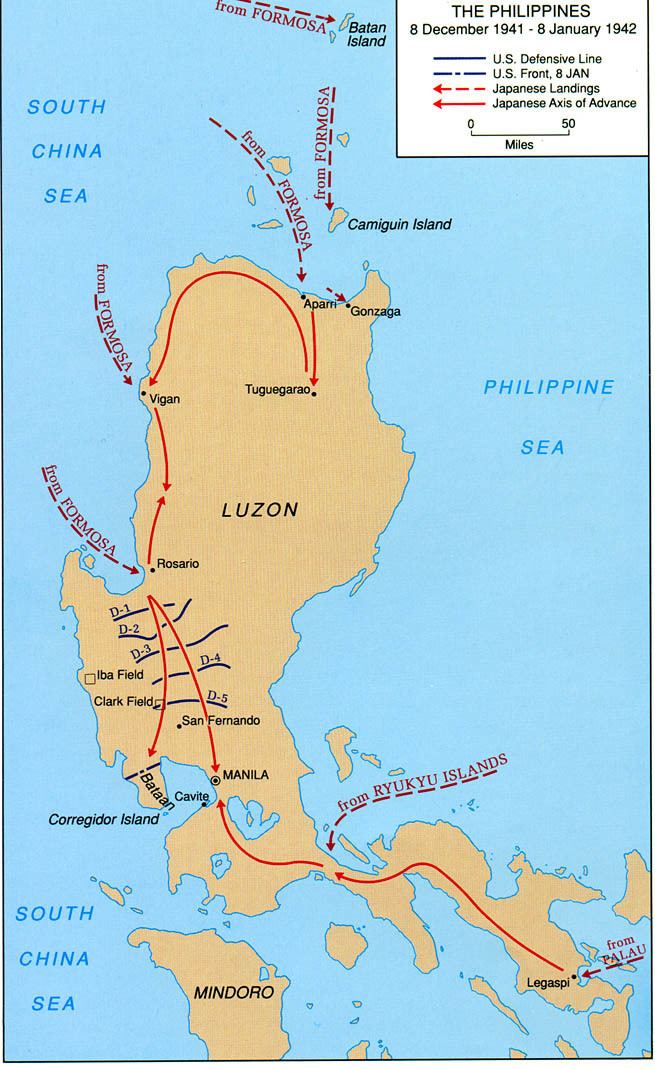 | ||
The Japanese invasion of Batan Island was the first step in their invasion of the Philippines, an American colony. The purpose was to obtain control of local air strips, which could be used as forward bases by fighter aircraft for operations further south in the Philippines. The attack on Batan Island was the first of several other advance landings; the other landings took place at Aparri, Vigan, Legaspi, Davao, and Jolo Island.
Contents
Background
The Japanese had been officially planning a strike on the American fleet at their main base at Pearl Harbor in the Territory of Hawaii since early 1941, but the idea had been informally speculated for many years.
Following the 1931 Japanese invasion of Manchuria, beginning the Second Sino-Japanese War, Japan spent considerable effort trying to isolate China and to obtain sufficient natural resources to attain victory in China. The 1940 Japanese invasion of French Indochina was such an effort to control supplies. In response, the United States halted shipments of airplanes, parts, machine tools, and aviation gasoline to Japan. In July 1941, the U.S. ceased oil exports to Japan, leaving the Japanese with the option of either withdrawing from China or securing new sources of raw materials in the resource-rich, European-controlled colonies of Southeast Asia, such as present-day Malaysia (United Kingdom) and Indonesia (Netherlands), both oil producers.
Early in 1941, President Franklin D. Roosevelt ordered a military buildup in the Philippines in the hope of discouraging further Japanese aggression in the Far East. Because the Japanese high command was certain that any attack on the United Kingdom’s Southeast Asian colonies would bring the United States into war, they planned a devastating first strike against Pearl Harbor and the Philippines.
Batan Island was the first part of the Japanese invasion of the Philippines, and occurred simultaneously with the attack on Pearl Harbor. Its main purpose was set up an air base for future operations against American forces on Luzon.
Landing and aftermath
The invasion was mainly launched from the Japanese port of Takao on Taiwan on 8 December 1941. The Batan Island invasion force, under the overall command of Vice Admiral Sueto Hirose, consisted of a 490-man naval combat unit and an indeterminate number of air corps troops, on two transports escorted by the destroyer Yamagumo and four torpedo boats. The combat troops quickly secured the existing small airfield outside Basco without resistance, and the air corps troops began expansion work the following day to make it suitable for fighters and reconnaissance aircraft. The same day, the first planes of the Imperial Japanese Army Air Service 24th and IJA 50th Fighter Regiments landed at Basco.
However, over the next few days, the success of the Japanese bombing of Clark Field rendered the base at Basco redundant, and work was discontinued. On 10 December, the Batan Island invasion force was withdrawn from Batan Island, and invaded Camiguin Island in the Babuyan Islands to the south. The landing again proceeded without incident, and possession of the small airstrip on Camiguin gave the Japanese a forward airbase only 35 miles from Aparri.
Consequences
In retrospect, the advance landings in northern Luzon, including at Batan Island and Camiguin, accomplished little of strategic or tactical value. The air fields seized were small, and with the rapid advance of the Japanese into central Luzon, were soon unnecessary for further operations.
